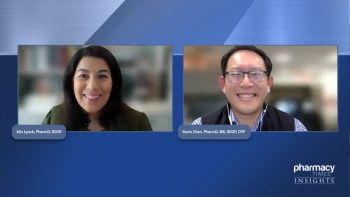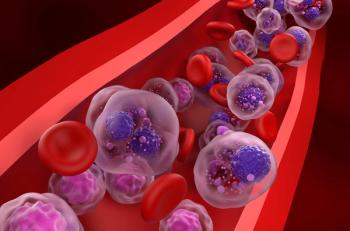
Individualizing Treatment Strategies for Patients with RRMM
Ryan Haumschild, PharmD, MS, MBA, leads a panel surrounding individualized strategies for treating patients with relapse/refractory (RR) MM.
Episodes in this series

Ryan Haumschild, PharmD, MS, MBA: Despite advances in the treatment of multiple myeloma, almost all patients will eventually relapse. Mr Hossain, how do you define relapsed or refractory multiple myeloma? How often are patients evaluated for these signs of relapse?
Shahrier Hossain, PharmD, BCOP: Broadly speaking, relapsed/refractory disease when their current or last therapy is no longer providing adequate control of their disease. It’s important to have context. Relapse could mean a patient coming in for monthly checks for regular refills, and we notice a gradual elevation of free light chains. However, it could also mean a doubling in their free light chains every month and suddenly we have an exploding disease. In terms of clinical parameters, we can have patients with anemia that’s getting worse and fatigue that’s getting worse. At the same time, there are patients with the explosive disease, and they suddenly have new plasmacytomas. We’ve also seen patients with new classes of leukemias that we can’t control anymore. Relapsed/refractory disease is all about context. Is this disease aggressive, or is it gradually progressing? Is it a clinical progression, or is it a biochemical progression?
There’s also the context of what’s going on with the patient. Is this a patient who’s on maintenance lenalidomide 10 mg phase 1 through 21, or is this someone who is triple-class refractory and needs extensive work-ups and an understanding of where the disease is? Do they need new marrow? Do they need a new PET [positron emission tomography]–CT scan?
For follow-up, there’s the routine lab follow-up, but if a patient is complaining of new aches or pains, new back pain, or anything of that nature, imaging sometimes isn’t warranted. I’m fortunate to be at an institution [Dana-Farber Cancer Institute] that does a lot of clinical trials, so I see a lot more bone marrows than any patient would want to see. That’s very useful to have as data.
Ryan Haumschild, PharmD, MS, MBA: Thanks for that overview. Obviously, there’s a lot to consider when we’re looking at every patient. Mr Ali, what patient-specific factors influence the choice of therapy in the relapsed/refractory multiple myeloma phase of care? How do you decide what treatments to offer each patient? Do you involve any patient preference in that treatment selection?
Amir Ali, PharmD, BCOP: Thank you, Mr Haumschild. Multiple myelomas aren’t usually curable. During the disease course, patients will usually experience multiple relapses. One of the objectives that we have in treating multiple myeloma is to see if we can extend the intervals between the times that these patients are relapsing. Mr Kirollos Hanna mentioned that the landscape for multiple myeloma has evolved quite a bit in recent years. In fact, if you look at FDA approvals, multiple myeloma has had the most FDA approvals of any malignancy, with new mechanisms and new treatment regimens. It’s growing very rapidly. With more of these treatment regimens, we can keep more patient-specific factors in mind when we come up with a treatment selection. Patient-specific factors include prior therapies, like an IMiD [immunomodulatory imide drug] or a proteasome inhibitor. Are they refractory to those types of treatments? How aggressive is their relapse? Are there any comorbidities, renal insufficiency, or renal impairment? All these things can affect a choice of therapy for multiple myeloma.
Another thing is comparing efficacy. This requires looking at the clinical trials and assessing the efficacy of these studies. As I mentioned, you’re trying to prolong the patients’ remission between each relapse. One way we measure this is progression-free survival. If you look at the studies and their median progression-free survival, that gives you a sense of how long you can keep that patient on therapy.
You’re asked about patient preference. Access to care is important for all these patients. It’s no good prescribing the drug to these patients. They don’t take it, and they’re not able to access care. We did an episode recently with Pharmacy Times® and talked about financial toxicity and how we can address some of these points when coming up with treatment options. Everything, from coming up with an oral option for patients to selecting a regimen that has a convenient dosing schedule, is extremely important when you see record-high gas prices and patients have to take off from work and find child care to come to the clinic for infusion. These are all important points when you’re coming up with treatment selections.
Ryan Haumschild, PharmD, MS, MBA: One thing you said that resonated with me is a reminder that multiple myeloma is a plasma cell disorder. There’s not necessarily a cure. We’re trying to sequence these agents appropriately, to treat it almost as a chronic disease, so these patients are able to live a long and functional life. Taking that into consideration, Mr Hossain, how does the length of remission change for each subsequent relapse? How does this influence your choice of therapy?
Shahrier Hossain, PharmD, BCOP: There was an article published a few years ago that showed that the length of remission is shorter for each subsequent line. The first line was approximately 12 months, the second line was about 7 months, the third line was about 6 months, and the fourth line was only 5 months. The depth of those responses also decreases with each line: 32% achieved a CR [complete response] in the first line vs 4% and 2% in the fifth line or beyond. VGPR [very good partial response] also showed a similar decrease from 74% in the first line to 11% in the fifth line. This is very similar to another study that showed that, at 12 months, the progression-free survival percentages decreased from 73% in the first line to 47% in the second line.
In our practice, we give patients the best available therapy. We have to keep in mind that when a patient relapses, they’re not necessarily the same patient as when we first saw them. These patients can get sicker and sicker. They age more. Other comorbidities can occur. For example, they can have issues with diabetes or cataracts, which means going to other appointments. They have other duties as well, so coming to the cancer hospital and then going to follow-up appointments with an eye doctor while taking belantamab may not be possible. Also, it’s important to recognize that a lot of these studies are over 6 years old. With the therapies that we have with CAR-T [chimeric antigen receptor T-cell therapy] and teclistamab, the responses may be different.
Ryan Haumschild, PharmD, MS, MBA: You did a good job talking about how these different therapies, while offering solutions for our patients, have limited efficacy as we go down the line. It’s not because these therapies aren’t good. These patients are treatment experienced based on combination regimens and mechanisms of action. It’s interesting because as we start to combine more products, we get deeper, more durable responses. But we also know that the costs continue to rise, and that’s a constant trade-off that we always think about. Our payer colleagues are always thinking about this as well.
Transcript edited for clarity.
Newsletter
Stay informed on drug updates, treatment guidelines, and pharmacy practice trends—subscribe to Pharmacy Times for weekly clinical insights.





































































































































































































